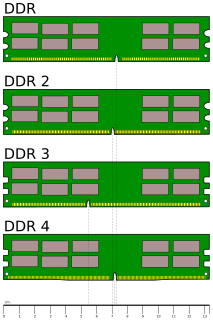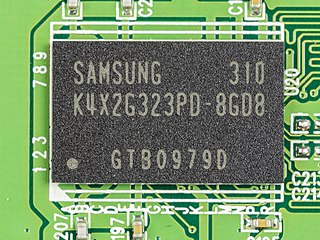A memory bank is a logical unit of storage in electronics, which is hardware-dependent. In a computer, the memory bank may be determined by the memory controller along with physical organization of the hardware memory slots. In a typical synchronous dynamic random-access memory (SDRAM) or double data rate SDRAM (DDR SDRAM), a bank consists of multiple rows and columns of storage units, and is usually spread out across several chips. In a single read or write operation, only one bank is accessed, therefore the number of bits in a column or a row, per bank and per chip, equals the memory bus width in bits (single channel). The size of a bank is further determined by the number of bits in a column and a row, per chip, multiplied by the number of chips in a bank.
Some computers have several identical memory banks of RAM, and use bank switching to switch between them. Harvard architecture computers have (at least) two very different banks of memory, one for program storage and other for data storage.
A memory bank is a part of cache memory that is addressed consecutively in the total set of memory banks, i.e., when data item a(n) is stored in bank b, data item a(n + 1) is stored in bank b + 1. Cache memory is divided in banks to evade the effects of the bank cycle time (see above) [=> missing "bank cycle" definition, above]. When data is stored or retrieved consecutively each bank has enough time to recover before the next request for that bank arrives. [1]
The number of memory modules needed to have the same number of data bits as the bus. A bank can consist of one or more memory modules.

In computing, memory is a device or system that is used to store information for immediate use in a computer or related computer hardware and digital electronic devices. The term memory is often synonymous with the term primary storage or main memory. An archaic synonym for memory is store.

Double Data Rate Synchronous Dynamic Random-Access Memory is a double data rate (DDR) synchronous dynamic random-access memory (SDRAM) class of memory integrated circuits used in computers. DDR SDRAM, also retroactively called DDR1 SDRAM, has been superseded by DDR2 SDRAM, DDR3 SDRAM, DDR4 SDRAM and DDR5 SDRAM. None of its successors are forward or backward compatible with DDR1 SDRAM, meaning DDR2, DDR3, DDR4 and DDR5 memory modules will not work in DDR1-equipped motherboards, and vice versa.

Dynamic random-access memory is a type of random-access semiconductor memory that stores each bit of data in a memory cell, usually consisting of a tiny capacitor and a transistor, both typically based on metal-oxide-semiconductor (MOS) technology. While most DRAM memory cell designs use a capacitor and transistor, some only use two transistors. In the designs where a capacitor is used, the capacitor can either be charged or discharged; these two states are taken to represent the two values of a bit, conventionally called 0 and 1. The electric charge on the capacitors gradually leaks away; without intervention the data on the capacitor would soon be lost. To prevent this, DRAM requires an external memory refresh circuit which periodically rewrites the data in the capacitors, restoring them to their original charge. This refresh process is the defining characteristic of dynamic random-access memory, in contrast to static random-access memory (SRAM) which does not require data to be refreshed. Unlike flash memory, DRAM is volatile memory, since it loses its data quickly when power is removed. However, DRAM does exhibit limited data remanence.

Synchronous dynamic random-access memory is any DRAM where the operation of its external pin interface is coordinated by an externally supplied clock signal.

A DIMM, commonly called a memory stick or RAM stick, comprises a series of dynamic random-access memory integrated circuits. These modules are mounted on a printed circuit board and designed for use in personal computers, workstations, printers, and servers. They are the predominant method for adding memory into a computer system. The vast majority of DIMMs are standardized through JEDEC standards, although there are proprietary DIMMs. DIMMs come in a variety of speeds and sizes, but generally are one of two lengths - PC which are 133.35 mm (5.25 in) and laptop (SO-DIMM) which are about half the size at 67.60 mm (2.66 in).
Semiconductor memory is a digital electronic semiconductor device used for digital data storage, such as computer memory. It typically refers to MOS memory, where data is stored within metal–oxide–semiconductor (MOS) memory cells on a silicon integrated circuit memory chip. There are numerous different types using different semiconductor technologies. The two main types of random-access memory (RAM) are static RAM (SRAM), which uses several MOS transistors per memory cell, and dynamic RAM (DRAM), which uses a MOS transistor and a MOS capacitor per cell. Non-volatile memory uses floating-gate memory cells, which consist of a single floating-gate MOS transistor per cell.
Column Address Strobe (CAS) latency, or CL, is the delay in clock cycles between the READ command and the moment data is available. In asynchronous DRAM, the interval is specified in nanoseconds. In synchronous DRAM, the interval is specified in clock cycles. Because the latency is dependent upon a number of clock ticks instead of absolute time, the actual time for an SDRAM module to respond to a CAS event might vary between uses of the same module if the clock rate differs.
XDR DRAM is a high-performance dynamic random-access memory interface. It is based on and succeeds RDRAM. Competing technologies include DDR2 and GDDR4.
In computing, serial presence detect (SPD) is a standardized way to automatically access information about a memory module. Earlier 72-pin SIMMs included five pins that provided five bits of parallel presence detect (PPD) data, but the 168-pin DIMM standard changed to a serial presence detect to encode much more information.
Memory refresh is the process of periodically reading information from an area of computer memory and immediately rewriting the read information to the same area without modification, for the purpose of preserving the information. Memory refresh is a background maintenance process required during the operation of semiconductor dynamic random-access memory (DRAM), the most widely used type of computer memory, and in fact is the defining characteristic of this class of memory.
Memory bandwidth is the rate at which data can be read from or stored into a semiconductor memory by a processor. Memory bandwidth is usually expressed in units of bytes/second, though this can vary for systems with natural data sizes that are not a multiple of the commonly used 8-bit bytes.

Error correction code memory is a type of computer data storage that uses an error correction code (ECC) to detect and correct n-bit data corruption which occurs in memory. ECC memory is used in most computers where data corruption cannot be tolerated, like industrial control applications, critical databases, and infrastructural memory caches.

In computing, a memory module or RAM stick is a printed circuit board on which memory integrated circuits are mounted. Memory modules permit easy installation and replacement in electronic systems, especially computers such as personal computers, workstations, and servers. The first memory modules were proprietary designs that were specific to a model of computer from a specific manufacturer. Later, memory modules were standardized by organizations such as JEDEC and could be used in any system designed to use them.
Double Data Rate 4 Synchronous Dynamic Random-Access Memory is a type of synchronous dynamic random-access memory with a high bandwidth interface.

Random-access memory is a form of computer memory that can be read and changed in any order, typically used to store working data and machine code. A random-access memory device allows data items to be read or written in almost the same amount of time irrespective of the physical location of data inside the memory, in contrast with other direct-access data storage media, where the time required to read and write data items varies significantly depending on their physical locations on the recording medium, due to mechanical limitations such as media rotation speeds and arm movement.

Low-Power Double Data Rate (LPDDR), also known as LPDDR SDRAM, is a type of synchronous dynamic random-access memory that consumes less power and is targeted for mobile computers and devices such as mobile phones. Older variants are also known as Mobile DDR, and abbreviated as mDDR.
This glossary of computer hardware terms is a list of definitions of terms and concepts related to computer hardware, i.e. the physical and structural components of computers, architectural issues, and peripheral devices.
Double Data Rate 5 Synchronous Dynamic Random-Access Memory is a type of synchronous dynamic random-access memory. Compared to its predecessor DDR4 SDRAM, DDR5 was planned to reduce power consumption, while doubling bandwidth. The standard, originally targeted for 2018, was released on 14 July 2020.
Row hammer is a security exploit that takes advantage of an unintended and undesirable side effect in dynamic random-access memory (DRAM) in which memory cells interact electrically between themselves by leaking their charges, possibly changing the contents of nearby memory rows that were not addressed in the original memory access. This circumvention of the isolation between DRAM memory cells results from the high cell density in modern DRAM, and can be triggered by specially crafted memory access patterns that rapidly activate the same memory rows numerous times.
Power consumption in relation to physical size of electronic hardware has increased as the components have become smaller and more densely packed. Coupled with high operating frequencies, this has led to unacceptable levels of power dissipation. Memory accounts for a high proportion of the power consumed, and this contribution may be reduced by optimizing data organization – the way data is stored.